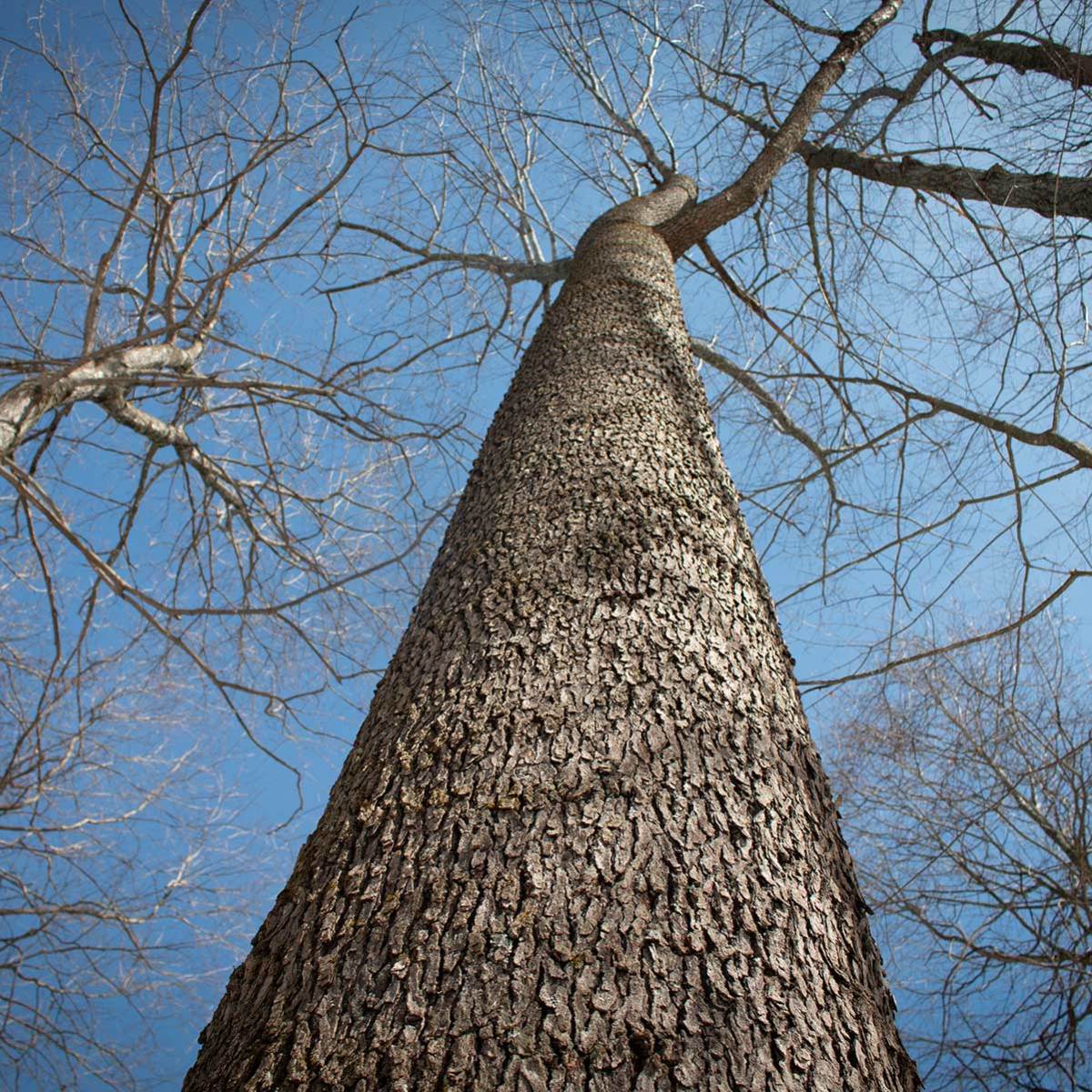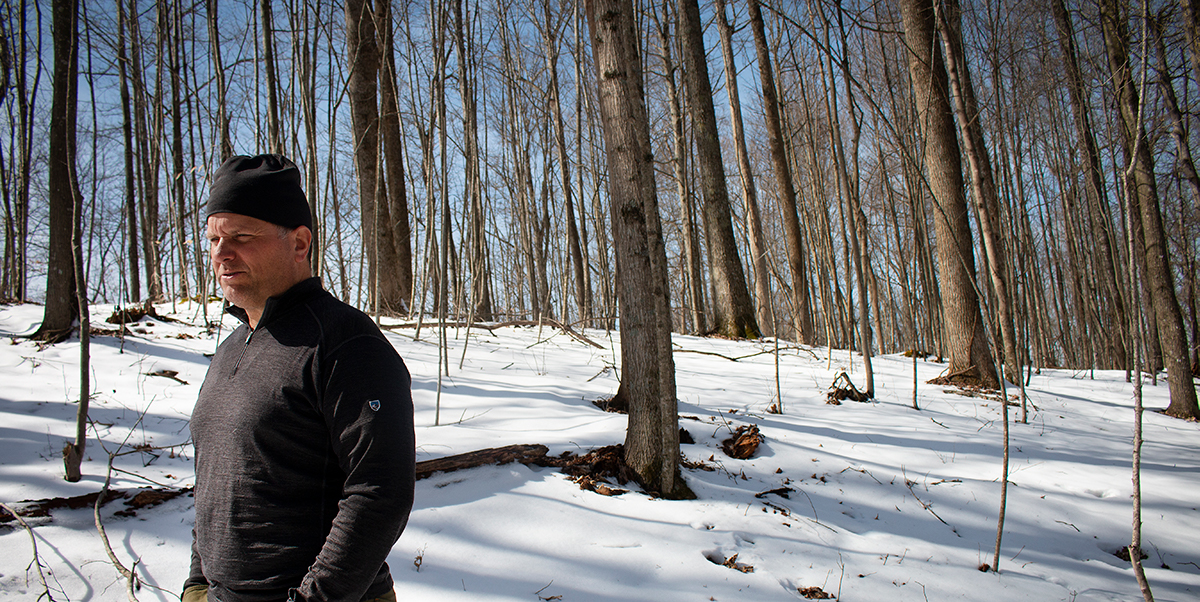Jarrod Hatfield has seen the world from 20,000 feet. He spent 20 years as a pilot in the Air Force and the West Virginia Air National Guard. Since retiring, he has worked as a commercial pilot for a major shipping company. Hatfield has also lived all over the United States, spending time in Alaska, Arkansas, Oklahoma, Texas and Wyoming.
But it’s coming home to his family’s 1,300 acres in Wyoming County, West Virginia, that keeps him grounded.
“I’ve really grown to appreciate it. I like the ruggedness of it,” said Hatfield, an REI Co-op Member since 1998.
The property is located deep in the state’s southern coalfields, and Hatfield knows it intimately. Growing up, he helped his dad, Rodney, fight fires along the ridges. He knows where to find wild game and morel mushrooms. He can tell you where the trillium and lady slippers bloom in the spring.
“It keeps me in my roots,” he says. “I’d hate to see my kids seeing vast tracts of land without (this) habitat.”
But a forest is a complicated heirloom. Healthy woodlands don’t stay that way on their own. They require active stewardship, to keep both plant and wildlife populations strong and invasive species at bay. Unlike a relative’s set of flatware, there are property taxes to pay annually, too.
It’s a lot to ask of a small landowner, which is why the American Forest Foundation and The Nature Conservancy created the new Family Forest Carbon Program, which helps small landowners create management plans for their forests. Crucially, it also provides them money to bankroll stewardship efforts on the land by generating and selling carbon credits.
How Forests Capture Carbon

To make sense of this, think back to your elementary school science class: During photosynthesis, trees pull carbon dioxide and water out of the air and soil, using CO2 to make oxygen and nutrients. The trees then release the oxygen back into the air and use the sugar to form roots, leaves and branches. Forests capture and sequester carbon at different rates, depending on the age and the number of trees in a stand.
“This is a uniquely impactful way for us to deliver on the co-op’s commitment to carbon neutral operations,” said Matthew Thurston, divisional vice president of sustainability at REI, an early supporter of the program.
Carbon credits represent one metric ton of carbon dioxide avoided or sequestered, in this case by nature. Companies purchase carbon credits to reduce their carbon footprints, often when they can’t reduce emissions on their own. Credits are sold through registries and verified through international standards and audited by third parties.
It’s a complicated system, which has up (until now) precluded the full participation of smaller landowners like Hatfield. Keeping up with those rules can be difficult, expensive and take years. The Family Forest Carbon Program helps alleviate those costs for participants, according to Barry Ulrich, deputy director for The Nature Conservancy, a nonprofit conservation group.
How the Program Works
Once they sign a 20-year contract, landowners receive an up-front payment followed by smaller, annual ones to cover the cost of maintaining a healthy forest. While most carbon programs only pay at the back end, it costs lots of money up front to implement sound forest practices—money that small forest owners often don’t have. The Family Forest Carbon Program is unique because it offers private forest owners the money they need to take better care of their parcels right away.
“We deconstructed the idea of what a carbon market is, and created it specifically for small landowners,” said Elizabeth Greener of the American Forest Foundation, a national conservation organization focused specifically on private forest owners.
Payments through the program vary based on a property’s size and how much carbon it can capture. Owners receive between $170 and $350 per acre.

Hatfield says he won’t get rich from that money, but it helps defer the costs of preserving the land. “It allows you to pay the taxes and keep the property with your family,” he said.
Hatfield’s forest is one of more than 150 registered in the program. Starting with Pennsylvania landowners in 2020, the program is now enrolling in West Virginia, Maryland, Vermont, Massachusetts and New York—with plans to expand to the Midwest and the South.
REI was an early supporter of the Family Forest Carbon Program. “This is a uniquely impactful way for us to deliver on the co-op’s commitment to carbon neutral operations,” said Matthew Thurston, divisional vice president of sustainability at REI. The program “expands sustainable forestry practices, provides family landowners with access to carbon markets and does so through a new methodology to ensure verifiable impacts.”
The program is open to landowners with properties as small as 30 acres and as large as 2,400 acres—though the average participant owns between 150 and 200 acres. Individual properties may be small, but family landowners collectively own 39 percent of the nation’s forests, according to the Forest Service.
There are plenty of carbon credits to be created and sold among this previously untapped market of small private forest owners, but Ulrich said the credits are only a way to fund this program. Its real goals are even more ambitious.
“People see this as a carbon program, but it’s not a carbon program. It’s (about) increasing the health of family forests,” Ulrich said. “We want to make healthier forests, for climate impact and biodiversity impact.”
When landowners sign up, the Family Forest Carbon Program provides them with a forester to create a long-term management plan.
“You can’t just do it in a year,” Greener said. “It’s going to take several years to get that forest that you want. You have to garden your forest.”
These plans are tailored to individual properties. All the plans share some common elements, though. Most important for carbon capture, owners agree they will not do any major logging during the 20-year contract. Landowners may need to harvest some of their lower-quality or unhealthy trees.
Removing undergrowth also reduces the fuel for forest fires and allows for better wildlife habitat. An overgrown forest can disrupt natural migration corridors, reducing the number of animals in a forest. And young, healthy growth can provide shelter for small mammals and bird species. This work also improves the local watershed since forests are nature’s water treatment facilities. And all this works together to help fight climate change.
Climate concerns are the main reasons landowners join the program, Ulrich said. Their children and grandchildren are conscious of the growing threat of climate change, and they’re beginning to think about their legacy.
Jarrod Hatfield also thinks about his children a lot. He sees the carbon program as a way to put wealth back into the region.
The forest he now stewards was once owned by a big land and mineral company until his grandfather Carl and his business partners purchased the surface rights to the land. They logged some sections and sold off other parcels. As the company’s operations wound down, Carl bought out his partners and kept the property.
Carl handed down the land to his son Rodney, Jarrod’s father, because he was an avid outdoorsman.
“He was a simple guy. He loved just hanging out on the property if it just meant riding back and looking at a walnut tree,” Hatfield said.
Rodney died in December 2021. Jarrod’s mother Alice still lives on the property, but Jarrod serves as the main steward.

Sometime soon, he plans to take his son and daughter on a hike and walk the entire boundary of the property. He wants to get them familiar with its ridges and hollows, the way his father taught him the intricacies of the land. He wants them to understand the importance of caring for it.
“To have that much land is an anomaly in this area,” Hatfield said. “And I want to keep it. I want to pass it on.”
Join the REI Cooperative Action Network to help pass the TREES Act. The legislation would bolster to bolster tree canopy in underserved neighborhoods.


